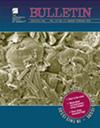地壳尺度地震反射测量揭示的北喜马拉雅穹隆构造演化
IF 3.7
1区 地球科学
Q1 GEOSCIENCES, MULTIDISCIPLINARY
引用次数: 0
摘要
片麻岩穹窿是碰撞造山运动的典型产物,是解读地壳变形和大陆碰撞演化历史的重要地质单元。然而,人们对它们的形成机制仍然知之甚少。围绕北喜马拉雅片麻岩穹隆带起源的争论就很好地说明了这一问题,该穹隆带的形成原因被归结为中间地壳通道流、推力-叠加发育、伸展剥离断层或与地壳部分熔化有关的陡崖流。这些模型预测了单个穹隆内部的不同结构,可以通过高分辨率地震成像进行检验。在此,我们展示了沿北喜马拉雅片麻岩穹隆区中心地带南北向长达 120 公里的横断面采集的最新地震反射数据。在地表地质观测的约束下,对地震数据的分析和解释表明:(1) 俯冲的印度下地壳与北喜马拉雅地区变形的中上地壳脱钩、(2) 地震勘探所成像的片麻岩穹隆的核心是结构厚度为 35 千米的地壳尺度叠加蚁状二叠体;以及 (3) 我们的地震剖面所成像的高反射片状体最好解释为片麻岩穹隆发育过程中同步发育的白云母侵入体。总之,我们的工作表明,北喜马拉雅片麻岩穹隆区是由共生地壳缩短和造山地壳部分熔化形成的。本文章由计算机程序翻译,如有差异,请以英文原文为准。
Structural evolution of the North Himalaya domes as revealed by crustal-scale seismic-reflection surveying
As the typical products of collisional orogeny, gneiss domes are important geological units with which to decipher the crustal deformation and evolutionary history of continental collision. However, their formation mechanisms remain poorly understood. This issue is well illustrated by the debate surrounding the origin of the North Himalaya gneiss dome zone, which has been attributed to middle-crustal channel flow, thrust-duplex development, extensional detachment faulting, or diapiric flow related to partial crustal melting. These models predict different internal structures within individual domes that can be tested by high-resolution seismic imaging. Here, we present newly acquired seismic-reflection data collected along an ∼120-km-long north-south traverse across the central segment of the North Himalaya gneiss dome zone. Analysis and interpretation of the seismic data constrained by surface geology observations imply that (1) the subducting Indian lower crust is decoupled from the deformed middle and upper crust in the North Himalaya, (2) a crustal-scale stack of antiformal duplexes with a structural thickness of ∼35 km defines the cores of the gneiss domes imaged by the seismic survey, and (3) highly reflective, sheetlike bodies imaged in our seismic profile are best interpreted as leucocratic intrusions developed synchronously during gneiss dome development. As a whole, our work suggests that the North Himalaya gneiss dome zone was created by coeval crustal shortening and partial melting of orogenic crust.
求助全文
通过发布文献求助,成功后即可免费获取论文全文。
去求助
来源期刊

Geological Society of America Bulletin
地学-地球科学综合
CiteScore
9.30
自引率
8.20%
发文量
159
审稿时长
4-8 weeks
期刊介绍:
The GSA Bulletin is the Society''s premier scholarly journal, published continuously since 1890. Its first editor was William John (WJ) McGee, who was responsible for establishing much of its original style and format. Fully refereed, each bimonthly issue includes 16-20 papers focusing on the most definitive, timely, and classic-style research in all earth-science disciplines. The Bulletin welcomes most contributions that are data-rich, mature studies of broad interest (i.e., of interest to more than one sub-discipline of earth science) and of lasting, archival quality. These include (but are not limited to) studies related to tectonics, structural geology, geochemistry, geophysics, hydrogeology, marine geology, paleoclimatology, planetary geology, quaternary geology/geomorphology, sedimentary geology, stratigraphy, and volcanology. The journal is committed to further developing both the scope of its content and its international profile so that it publishes the most current earth science research that will be of wide interest to geoscientists.
 求助内容:
求助内容: 应助结果提醒方式:
应助结果提醒方式:


